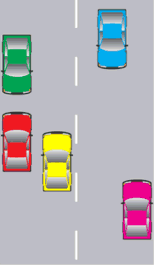Online driving tutorials
I think meeting is one of the most difficult aspects of driving. It's all to do with how motorists get past one another when the road narrows. A driver needs to be able to read a situation, size it up, make a decision and act upon it all within a second or two. Drivers with minimal experience can't do this. Hence why meeting situations are so hard for them.
Always think clearance
Depending on the width of the road, parked vehicles and oncoming traffic, you'll be expected to deal with each situation slightly differently.
Wide roads with the occasional parked car - On approach to the obstruction on your side of the road, check the interior mirror then the right door mirror for other road users trying to overtake you before moving out. Start to drift away from the left early and take up a position 1 meter from the parked car and once you've passed it check the interior mirror and left door mirror for people, smaller vehicles and bikes behind the parked car.
Make sure you can see the back of the car before moving back in. Students often check the mirrors too soon and therefore come back in too soon. If you can keep a meter from the parked up cars and the oncoming traffic, this is deemed a safe distance and you can continue at normal speed.
A common issue is not moving out early enough. Try to be parallel and flush with the parked up cars when you go past them. This way you'll take the minimum amount of space. Plus, the oncoming traffic will read your intentions early and will try and accommodate you.
Normal/average width road - reduce speeds
In the average sized road, you run the risk of slowing oncoming vehicles down when you move out and around the parked cars. If the gap between you, the parked car and oncoming road users is less than 1 meter, then you must reduce your speed accordingly.
If the gap is less than 1 meter, you must be traveling at no more than 20 mph by the time you meet the oncoming car.
At these speeds you'll be able to deal with car doors being flung and going ahead with the emergency stop. You will need to be able to identify the gap and the width before you get there and have your speed under control when you pass the other cars. Same routine as far as the mirrors are concerned.
Narrow roads - Hold back
If you can't give at least 1/2 a meters clearance when passing another car, you should be stopping.
They have priority. If it's just one car, then back off with the speed on approach and once they have gone, check those mirrors, move out and make some progress. If there are lots of cars coming, then you'll need to stop. You must take up the 'Hold Back' position.
The sooner you stop, the more time you have to get the ready for moving away once again. First gear, and maybe the handbrake needs to be applied. The early reduction in speed lets the oncoming traffic know your plans too.
Stop no closer than 2 to 3 car lengths from the first parked vehicle (that's a pretty big distance).
Too close to the kerb and cars behind will start overtaking you. Make it obvious you are just waiting. Half a car width in is usually right. You'll then be able to see down the road and know what's coming.
Tunnel of vehicles
With these situations, priority goes to the car who gets in first.
Holding back sooner rather than later is advised, as there may be nowhere to pass each other later. Reversing down a narrow street is way harder than it sounds.
If for what ever reason you do find yourself in a tunnel of cars with someone coming towards you, find somewhere to pass each other. Gaps on the other side of the street are the easy ones. Simply stop opposite a large gap and allow them, to move into it. Gaps on our side are more difficult. Have it clear in your head that you're going to stop here.
Clutch goes down before we get into the gap, so the engine stops pushing the wheels. Only move in the absolute minimum, we want to get out again easily and make sure it doesn't look like you're parking. Try to stop in the middle of the gap to aid an easy exit with your wheels pointing a little to the right to help further. Have the car parallel with the kerb.
The video below shows how meeting situations should be dealt with.






